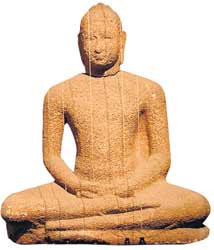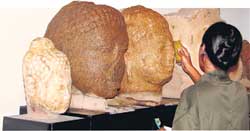
| Stones of many shapes, different histories Heralding the thematic galleries, the National Museum Colombo gets a new addition It began with Anuradhapura and Polonnaruwa and went on to Kandy. Come November 1, visitors to the National Museum will be able to enjoy yet another gallery, this time devoted to stone antiquities.
The National Museum, Colombo, established in 1877, housing some of our most historic and valuable artefacts, as well as sections displaying the art of puppetry, a library with some 500,000 books and more than 4,000 ancient palm leaf manuscripts is tangible proof of the country’s rich culture and heritage. In an effort to preserve this heritage, the Hongkong
and Shanghai Banking Corporation, has, since 2004, in partnership
with the Museum revamped and refurbished a number of galleries focusing
on various eras of our history. The latest, the Stone Antiquities
Gallery will be opened on November 1.
Stone artefacts from the Anuradhapura Period right up to the British Period will be on display at the new gallery. “Stone inscriptions, sculptures, Bodhi Sathwa statues, decorative objects and utensils are some of the historical artefacts the public will be able to view once the gallery is opened,” she added. Some of the highlights among the range of items on display are the numerous slab inscriptions in old Sinhalese, Tamil, Arabic, Portuguese, Dutch and English, a unique stone water filter, religious icons, architectural edifices, architectonic and decorative sculptures and historic documents in the form of stone pillars. The Stone Antiquities Gallery is primarily categorised into four sections. “The four sections of the gallery are the stone carvings, epigraphy focusing on stone inscriptions, the Hindu section and the Buddhist section,” said Museum Keeper Ranjith Hewage, explaining the layout of the gallery.
In the Gallery plan, the Buddhist and Hindu sculptures are centrally placed, while decorative sculptures, votive objects, inscriptions and household ware occupy spaces of the passages on either side as well as the exterior corridors. The Buddhist section includes icons of Buddha, Bodhisatva and other divinities, symbols such as footprints and relic caskets, decorative elements of the flights of steps of ancient monuments such as guardstones and moonstones and directional animals. The Hindu section has Hindu god-heads of Shiva, Vishnu, Parvati, Surya, Skanda, Ganesha, and vehicles of the gods. The decorative sculptures mainly consists of friezes of processions with dancers and drummers, rows of dancing dwarfs, votive offerings and a beautifully decorated array of pillars. A senior Archaeologist-cum-Museologist of international repute, Prof. Leelananda Prematileke together with his team is at present working on the Gallery, getting it ready for public viewing on November 1. |
| || Front
Page | News
| Editorial
| Columns
| Sports
| Plus
| Financial
Times | International
| Mirror
| TV
Times | Funday
Times || |
| |
Copyright
2006 Wijeya
Newspapers Ltd.Colombo. Sri Lanka. |


